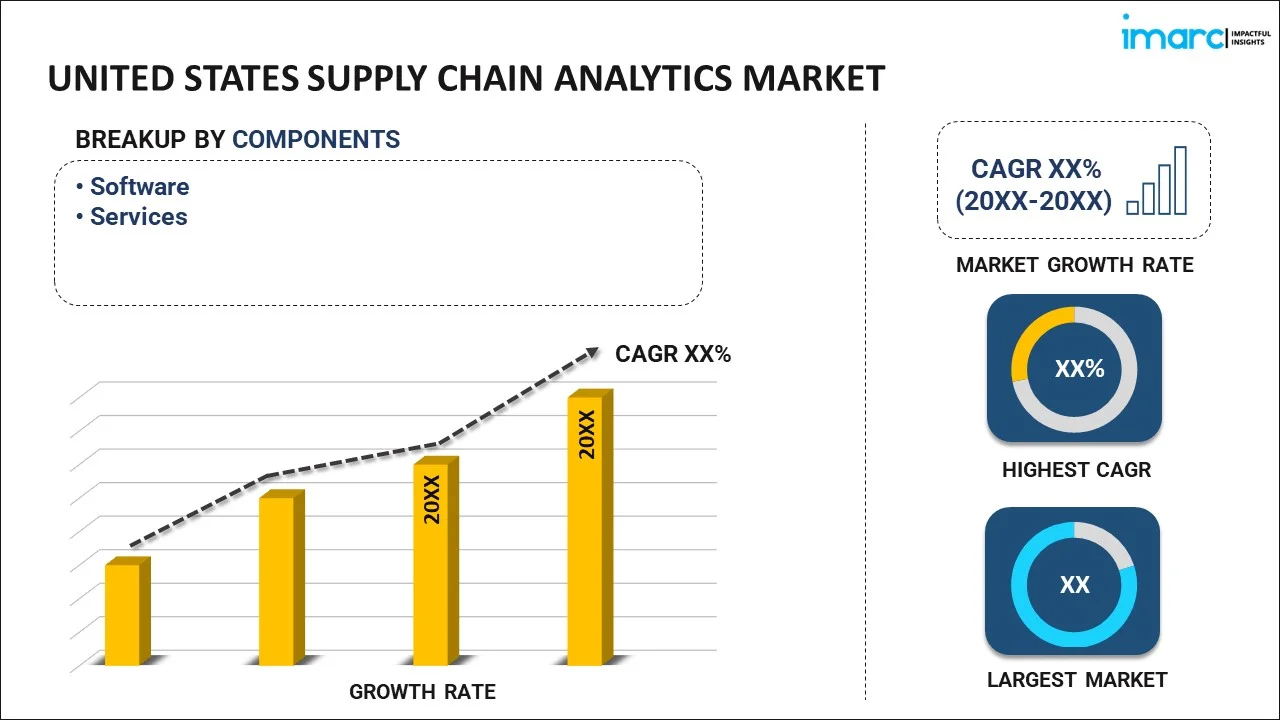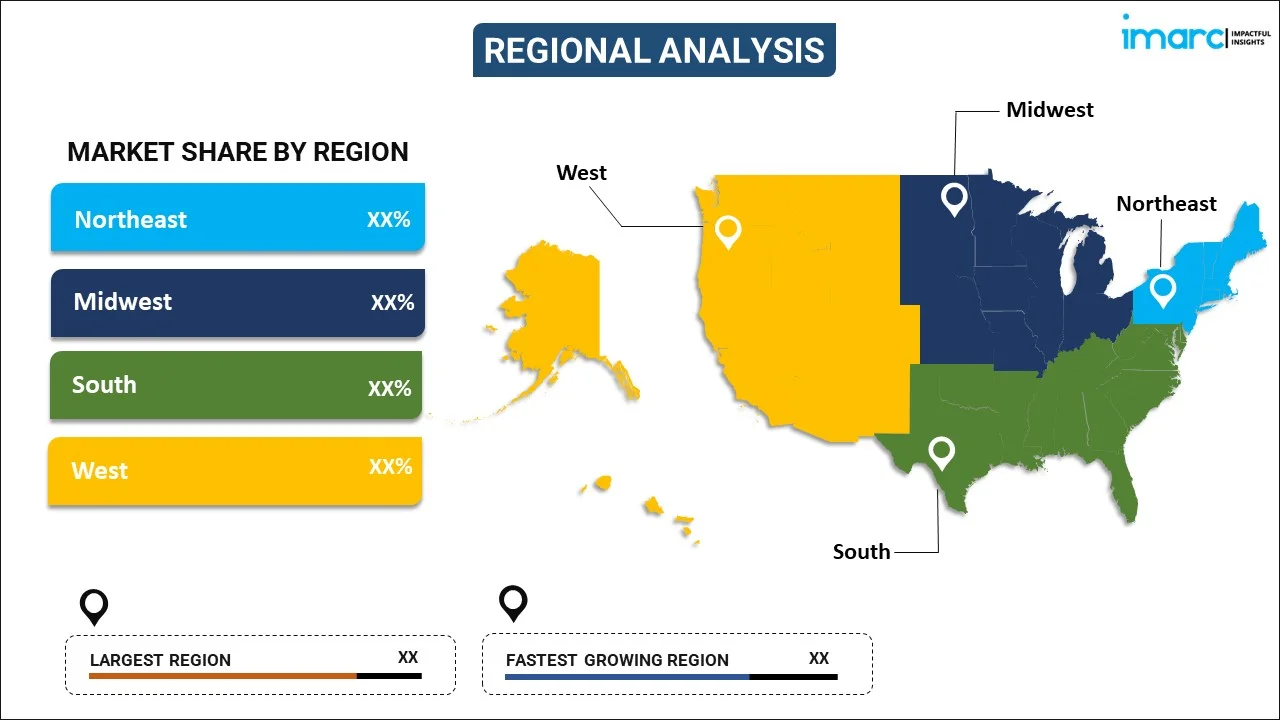
United States Supply Chain Analytics Market Report by Component (Software, Services), Deployment Mode (On-premises, Cloud-based), Enterprise Size (Large Enterprises, Small and Medium Enterprises), Industry Vertical (Automotive, Food and Beverages, Healthcare and Pharmaceuticals, Manufacturing, Retail and Consumer Goods, Transportation and Logistics, and Others), and Region 2025-2033
Market Overview:
United States supply chain analytics market size is projected to exhibit a growth rate (CAGR) of 21.20% during 2025-2033. The integration of artificial intelligence and machine learning technologies in supply chain analytics, which enables more accurate demand forecasting, predictive maintenance, and optimization of various processes, is driving the market.
|
Report Attribute
|
Key Statistics
|
|---|---|
|
Base Year
|
2024 |
|
Forecast Years
|
2025-2033
|
|
Historical Years
|
2019-2024
|
| Market Growth Rate (2025-2033) | 21.20% |
Supply chain analytics involves the use of data analysis and technological tools to enhance the efficiency and performance of supply chain processes. It encompasses the collection, interpretation, and application of data to optimize various aspects of the supply chain, such as inventory management, demand forecasting, and logistics. By leveraging advanced analytics, machine learning, and statistical modeling, organizations can gain valuable insights into their supply chain operations, identify patterns, and make informed decisions to improve overall performance. This data-driven approach enables businesses to minimize costs, reduce risks, enhance customer satisfaction, and adapt to dynamic market conditions. Ultimately, supply chain analytics plays a crucial role in fostering agility and competitiveness in the ever-evolving landscape of supply chains.
United States Supply Chain Analytics Market Trends:
The supply chain analytics market in the United States is witnessing robust growth, primarily fueled by the escalating demand for enhanced operational efficiency across diverse industries. To begin with, the increasing complexity of regional supply chains has become a pivotal driver, necessitating advanced analytics tools to navigate intricate networks seamlessly. Additionally, the rising prevalence of data-driven decision-making underscores the importance of analytics in optimizing the supply chain. Moreover, the advent of advanced technologies such as artificial intelligence and machine learning has significantly propelled the demand for analytics solutions, enabling organizations to glean actionable insights from vast datasets. Furthermore, the intensifying focus on cost reduction and resource optimization is steering companies towards adopting supply chain analytics to identify areas for improvement and streamline processes. Coupled with this, the growing awareness of the significance of predictive analytics in forecasting demand and mitigating risks has become a key catalyst for market expansion. In tandem, the increasing need for real-time visibility into the supply chain performance is driving the adoption of analytics solutions, empowering businesses to proactively address challenges and capitalize on opportunities. In conclusion, the convergence of these drivers underscores the pivotal role that supply chain analytics plays in fostering agility, resilience, and competitiveness in today's dynamic business landscape.
United States Supply Chain Analytics Market Segmentation:
IMARC Group provides an analysis of the key trends in each segment of the market, along with forecasts at the country level for 2025-2033. Our report has categorized the market based on component, deployment mode, enterprise size, and industry vertical.
Component Insights:

- Software
- Demand Analysis and Forecasting
- Supplier Performance Analytics
- Spend and Procurement Analytics
- Inventory Analytics
- Transportation and Logistics Analytics
- Services
- Professional
- Support and Maintenance
The report has provided a detailed breakup and analysis of the market based on the component. This includes software (demand analysis and forecasting, supplier performance analytics, spend and procurement analytics, inventory analytics, and transportation and logistics analytics) and services (professional and support and maintenance).
Deployment Mode Insights:
- On-premises
- Cloud-based
A detailed breakup and analysis of the market based on the deployment mode have also been provided in the report. This includes on-premises and cloud-based.
Enterprise Size Insights:
- Large Enterprises
- Small and Medium-sized Enterprises
The report has provided a detailed breakup and analysis of the market based on the Enterprise Size. This includes large enterprises and small and medium-sized enterprises.
Industry Vertical Insights:
- Automotive
- Food and Beverages
- Healthcare and Pharmaceuticals
- Manufacturing
- Retail and Consumer Goods
- Transportation and Logistics
- Others
A detailed breakup and analysis of the market based on the Industry Vertical have also been provided in the report. This includes automotive, food and beverages, healthcare and pharmaceuticals, manufacturing, retail and consumer goods, transportation and logistics, and others.
Regional Insights:

- Northeast
- Midwest
- South
- West
The report has also provided a comprehensive analysis of all the major regional markets, which include Northeast, Midwest, South, and West.
Competitive Landscape:
The market research report has also provided a comprehensive analysis of the competitive landscape in the market. Competitive analysis such as market structure, key player positioning, top winning strategies, competitive dashboard, and company evaluation quadrant has been covered in the report. Also, detailed profiles of all major companies have been provided.
United States Supply Chain Analytics Market Report Coverage:
| Report Features | Details |
|---|---|
| Base Year of the Analysis | 2024 |
| Historical Period | 2019-2024 |
| Forecast Period | 2025-2033 |
| Units | Million USD |
| Scope of the Report | Exploration of Historical Trends and Market Outlook, Industry Catalysts and Challenges, Segment-Wise Historical and Future Market Assessment:
|
| Components Covered |
|
| Deployment Modes Covered | On-premises, Cloud-based |
| Enterprise Sizes Covered | Large Enterprises, Small and Medium Enterprises |
| Industry Verticals Covered | Automotive, Food and Beverages, Healthcare and Pharmaceuticals, Manufacturing, Retail and Consumer Goods, Transportation and Logistics, Others |
| Regions Covered | Northeast, Midwest, South, West |
| Customization Scope | 10% Free Customization |
| Post-Sale Analyst Support | 10-12 Weeks |
| Delivery Format | PDF and Excel through Email (We can also provide the editable version of the report in PPT/Word format on special request) |
Key Questions Answered in This Report:
- How has the United States supply chain analytics market performed so far and how will it perform in the coming years?
- What has been the impact of COVID-19 on the United States supply chain analytics market?
- What is the breakup of the United States supply chain analytics market on the basis of component?
- What is the breakup of the United States supply chain analytics market on the basis of deployment mode?
- What is the breakup of the United States supply chain analytics market on the basis of enterprise size?
- What is the breakup of the United States supply chain analytics market on the basis of industry vertical?
- What are the various Components in the value chain of the United States supply chain analytics market?
- What are the key driving factors and challenges in the United States supply chain analytics?
- What is the structure of the United States supply chain analytics market and who are the key players?
- What is the degree of competition in the United States supply chain analytics market?
Key Benefits for Stakeholders:
- IMARC’s industry report offers a comprehensive quantitative analysis of various market segments, historical and current market trends, market forecasts, and dynamics of the United States supply chain analytics market from 2019-2033.
- The research report provides the latest information on the market drivers, challenges, and opportunities in the United States supply chain analytics market.
- Porter's five forces analysis assist stakeholders in assessing the impact of new entrants, competitive rivalry, supplier power, buyer power, and the threat of substitution. It helps stakeholders to analyze the level of competition within the United States supply chain analytics industry and its attractiveness.
- Competitive landscape allows stakeholders to understand their competitive environment and provides an insight into the current positions of key players in the market.
Need more help?
- Speak to our experienced analysts for insights on the current market scenarios.
- Include additional segments and countries to customize the report as per your requirement.
- Gain an unparalleled competitive advantage in your domain by understanding how to utilize the report and positively impacting your operations and revenue.
- For further assistance, please connect with our analysts.
 Inquire Before Buying
Inquire Before Buying
 Speak to an Analyst
Speak to an Analyst
 Request Brochure
Request Brochure
 Request Customization
Request Customization




.webp)




.webp)












